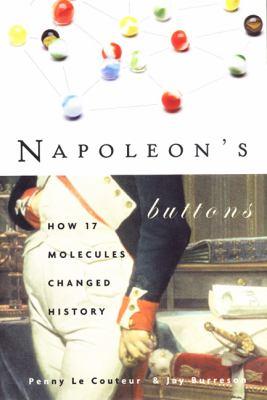
Napoleon's buttons : how 17 molecules changed history
Available Copies by Location
| Location | |
|---|---|
| Victoria | Available |
Browse Related Items
| Subject |
| Chemistry. Chemistry > History. |
- ISBN: 1585422207
- Physical Description 375 pages : illustrations
- Publisher New York : Jeremy P. Tarcher/Putnam, [2003]
- Copyright ©2003
Content descriptions
| Bibliography, etc. Note: | Includes bibliographical references (pages 357-362) and index. |
| Immediate Source of Acquisition Note: | LSC 37.50 |
Additional Information

CHOICE_Magazine Review
Napoleon's Buttons : How 17 Molecules Changed History
CHOICE
Copyright American Library Association, used with permission.
As a literary device, the proposition that the course of history would have been otherwise but for the intervention of emergent technology is a good one. From the buttons of the title to mother-in-law silk, the 17 mostly familiar stories in this book are pleasingly retold by Le Couteur (chemistry, Capilano College, British Columbia) and Burreson, an industrial chemist. But for serious readers, the genre has been better conceived and executed without condescension by others. These chemist authors deserve an editor with a more literary point of view. The collection frustratingly fails to get beyond pedantic style, gratuitous historical speculation, and, in too many cases, chemical formulas that just get in the way. Youthful readers, though, are likely to discover some of chemistry's most wonderful lessons from history in readable form. ^BSumming Up: Recommended. General readers; lower-division undergraduate through graduate students. L. W. Fine Columbia University

BookList Review
Napoleon's Buttons : How 17 Molecules Changed History
Booklist
From Booklist, Copyright (c) American Library Association. Used with permission.
Women who use birth control pills probably care more about their effectiveness than about how they actually work, and although ignorance here may be bliss, it also cheats one of a good science story, involving a driven chemist making a serendipitous discovery about cortisone. Le Couteur and Burreson roll out 17 episodes selected for their salience in affecting health as well as history at large. This pair of chemists doesn't overinterpret a particular chemical as a historical influence but makes speculating on, say, piperene, a sporting diversion. Piperene is the molecule that causes taste buds to sting from pepper. Venice had a monopoly on the pepper trade, which rivals wished to break, motivating the voyages of discovery. Although connections frame the authors' tales (the title refers to tin buttons, which contributed to Napoleon's defeat in Russia), each story dwells on its molecular protagonist. The authors diagram the formula and shape of each, from the polymer behind the sheen in silk to the ionic bonds in the taste of salt. Well-conceived, well-done popular science. --Gilbert Taylor

Kirkus Review
Napoleon's Buttons : How 17 Molecules Changed History
Kirkus Reviews
Copyright (c) Kirkus Reviews, used with permission.
Two scientists entertainingly explore the intersections between chemistry and history, such as the French army uniform buttons made of tin, which crumbles to dust in low temperatures, that some scholars blame for the failure of Napoleon's Russian campaign. In their very brief introduction, Le Couteur (Chemsitry/Capilano College, British Columbia) and industrial chemist Burreson outline the basics of molecular structures, emphasizing how much difference even an apparently tiny alteration can make. The bulk of the text consists of 17 chapters devoted to individual molecules or related groups of molecules, natural as well as synthetic, covering almost every area of human activity. Peppers, nutmeg, and cloves set off a wave of explorations and conquests beginning in the late Middle Ages and ending with European colonies around the globe. The discovery of ascorbic acid, better known as vitamin C, made possible the long voyages that solidified the colonial powers' grip on their empires. Nitro compounds, in particular gunpowder and other explosives, are key ingredients in the change from the stylized combat of medieval warfare to the bombs and rockets of today. Other chemicals made their impact closer to home: mauve, the synthetic dye that named a decade; and nylon, which changed the face of women's fashions. The addictive chemicals nicotine, morphine, and caffeine have played sinister roles in the oppression of native peoples in several parts of the world, but so have cellulose and sucrose, the central molecules of cotton and sugar. Many chemical substances have had ambiguous histories; the insecticide DDT, now outlawed in much of the world, contributed greatly to the virtual disappearance of mosquito-borne diseases such as malaria from developed countries. The authors unearth a wealth of anecdotes from all parts of the world and use them effectively to illustrate the technological underpinnings of modern society. Thoughtful, often surprising, smoothly written. Copyright ©Kirkus Reviews, used with permission.

Library Journal Review
Napoleon's Buttons : How 17 Molecules Changed History
Library Journal
(c) Copyright Library Journals LLC, a wholly owned subsidiary of Media Source, Inc. No redistribution permitted.
The anecdote of the titular buttons is related in the introduction: supposedly, the tin buttons on the uniforms of Napoleon's army became brittle and disintegrated in the cold Russian winter, contributing to his defeat. Le Couteur, a chemistry teacher, and Burreson, an industrial chemist, expand this theme to explore how chemical properties of compounds have altered history. The impacts run the gamut from medicine (e.g., penicillin, vitamin C) to social change (e.g., the contraceptive pill and slavery perpetuated by the farming of glucose, or sugar cane, and cellulose, or cotton) to more direct historical incidents such as the Opium Wars or the spice trade spurring New World exploration. The authors violate the dictate of modern popular science writing that proscribes including chemical formulae but to good effect-by showing the structures of the compounds, they convey how shapes affect function. This book devotes more space to fewer substances than John Emsley's Molecules at an Exhibition, but it doesn't fall into the hyperbolic monomania of other popular "chemicals-that-changed-the-world" books like Simon Garfield's Mauve. Recommended for public and academic libraries.-Wade M. Lee, Univ. of Toledo Libs. (c) Copyright 2010. Library Journals LLC, a wholly owned subsidiary of Media Source, Inc. No redistribution permitted.


